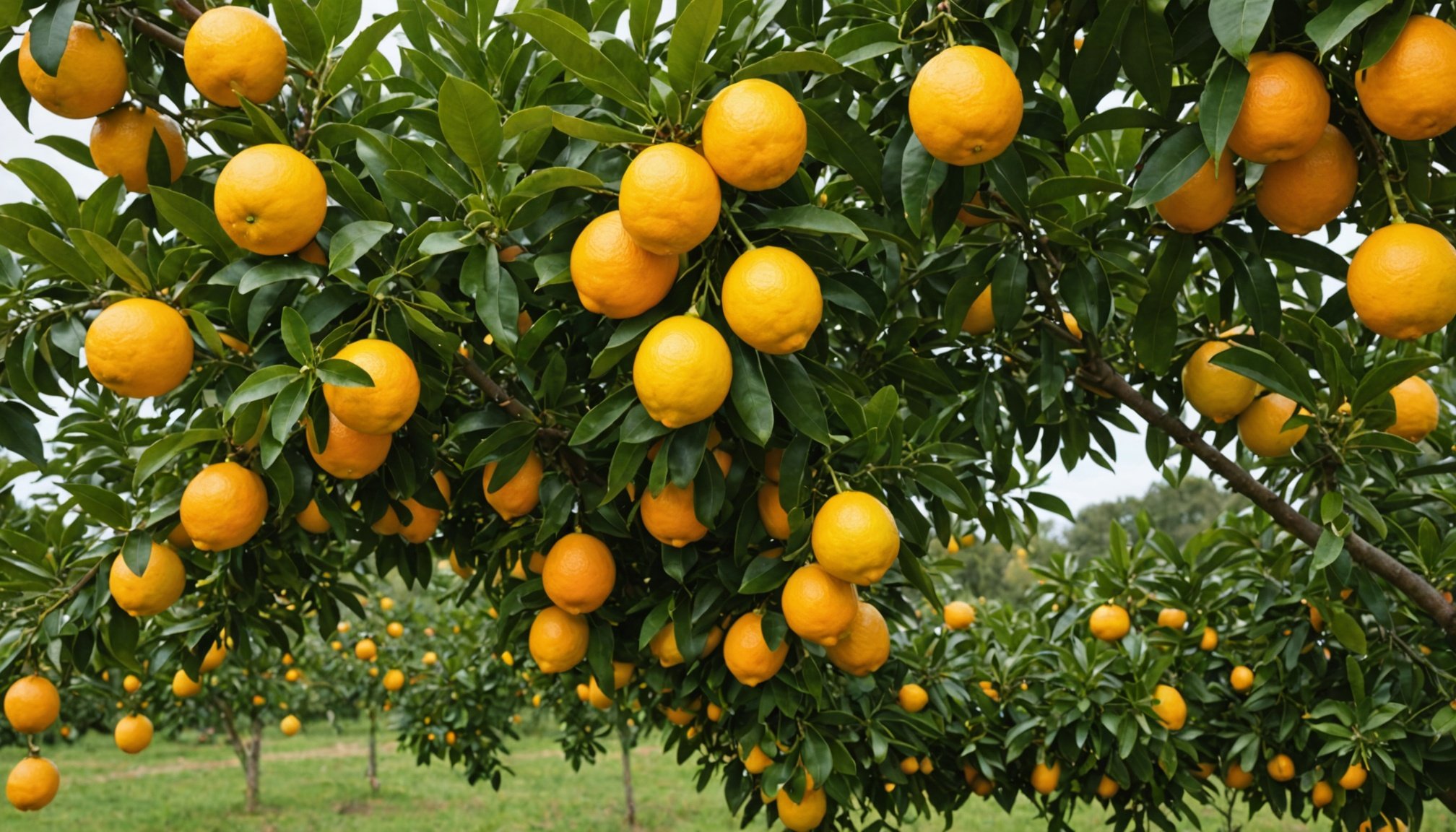Citrus trees are becoming an increasingly viable option for UK gardeners as climate change alters traditional growing conditions. Understanding how to adapt to these shifts is essential for cultivating healthy, productive trees. This guide provides practical tips to help you succeed with citrus cultivation, addressing challenges and offering insights tailored to the unique UK climate. Whether a novice or experienced gardener, learn how to nurture these vibrant trees and enjoy their rewards.
Overview of Citrus Trees in the UK
Growing citrus trees in the UK can be a rewarding endeavour, offering both aesthetic and practical benefits. These trees not only enhance garden landscapes with their vibrant foliage and fragrant blossoms but also provide fresh, home-grown fruits. However, successfully cultivating citrus in the UK requires understanding the unique climate challenges and opportunities.
En parallèle : Ultimate Guide: Watering Your Succulent Garden in the UK Climate – How Often is Just Right?
The UK climate is characterised by its cool temperatures and frequent rainfall, which can pose challenges for citrus cultivation. Citrus trees typically thrive in warmer, sunnier climates, making it essential to select varieties that can withstand the UK's conditions. Despite these challenges, the temperate climate also offers opportunities, such as reduced risk of extreme heat stress that can affect citrus in hotter regions.
To navigate these climate constraints, it is crucial to choose suitable citrus varieties. Some varieties more adaptable to the UK climate include Meyer lemons, which are known for their hardiness and ability to produce fruit even in cooler temperatures. Other options like Satsuma mandarins or Kumquats can also be considered due to their resilience and compact growth habit, making them ideal for container planting.
Cela peut vous intéresser : Transform Your UK Urban Garden: A Step-by-Step Guide to Building a Sustainable Composting System
By selecting the right varieties and providing appropriate care, UK gardeners can enjoy the many benefits of growing citrus trees.
Suitable Citrus Varieties for the UK
Selecting the best citrus varieties for the UK is crucial for successful cultivation. Certain varieties are more adaptable to the UK's climate, offering a better chance of thriving despite the cooler temperatures and frequent rainfall.
Overview of Hardy Citrus Varieties
Among the hardy varieties, the Meyer lemon stands out due to its ability to produce fruit even in cooler conditions. Its hardiness makes it a popular choice for gardeners seeking a reliable citrus option. Similarly, Satsuma mandarins are known for their resilience and can withstand lower temperatures, making them suitable for the UK climate.
Characteristics of Popular Choices
- Lemons: Meyer lemons are particularly well-suited for the UK, offering a sweeter taste and a hardier nature compared to traditional lemons.
- Limes: While more challenging, some lime varieties can adapt with proper care and protection during colder months.
- Oranges: Satsuma mandarins are a preferred choice due to their compact growth and ability to thrive in containers, ideal for limited space or indoor environments.
Recommendations Based on Regional Climate Variations
For those in milder regions, a broader range of citrus may be feasible. However, in cooler areas, prioritising hardy varieties like Meyer lemons and Satsuma mandarins ensures a more successful and rewarding citrus-growing experience.
Climate Adaptation Techniques
Successfully growing citrus trees in the UK requires strategic climate adaptation to overcome weather challenges. Understanding and implementing effective growing techniques can significantly enhance the resilience of these trees against the unpredictable UK climate.
Strategies for Frost Protection
Frost can be detrimental to citrus trees. To safeguard them, consider using frost cloths or horticultural fleece to cover the trees during cold spells. These materials provide a protective layer that helps retain heat and prevent frost damage. In addition, applying a thick layer of mulch around the base of the trees can insulate the roots and maintain soil warmth.
Importance of Planting Location and Orientation
Choosing the right planting location is crucial for weather resilience. Position citrus trees in south-facing spots to maximise sun exposure, which is vital for their growth and fruit production. Ensure the site is sheltered from harsh winds, which can exacerbate cold conditions and stress the trees.
Utilizing Microclimates
Creating or taking advantage of microclimates can further enhance growth. Planting near walls or fences can provide additional warmth and protection, as these structures absorb and radiate heat. This approach can create a more favourable environment for citrus trees, promoting healthier development and increased yield.
Soil and Care Requirements
Ensuring optimal soil quality is vital for the successful cultivation of citrus trees in the UK. The ideal soil should be well-draining to prevent waterlogging, which can harm the roots. Sandy loam is often recommended, as it strikes a balance between drainage and nutrient retention. If your garden soil is heavy clay or overly sandy, consider amending it with organic matter like compost to improve its structure and fertility.
Citrus tree care involves regular monitoring and adjustments to maintain a healthy growing environment. Begin by preparing the soil thoroughly before planting. This involves loosening the soil to enhance aeration and mixing in amendments if necessary. Regular mulching can help retain moisture and regulate soil temperature.
Fertilization is another crucial aspect of citrus tree care. A balanced fertilization schedule tailored to the nutrient needs of citrus trees can promote robust growth and fruiting. Typically, a citrus-specific fertiliser applied every 4-6 weeks during the growing season will suffice. Pay attention to signs of nutrient deficiencies, such as yellowing leaves, and adjust fertiliser types or amounts accordingly.
By adhering to these soil and care guidelines, UK gardeners can optimise their citrus trees' health and productivity.
Pest Management Strategies
Effectively managing pests is crucial for maintaining healthy citrus trees in the UK. Common pests, such as aphids, scale insects, and spider mites, can threaten the vitality of your trees. Identifying these pests early is key to preventing extensive damage. Aphids are small, soft-bodied insects that cluster on new growth, while scale insects appear as small, shell-like bumps on stems and leaves. Spider mites, although tiny, cause visible webbing and speckling on leaves.
In addition to pests, citrus trees are susceptible to diseases like citrus canker and root rot. Citrus canker presents as raised, corky lesions on leaves and fruit, while root rot causes wilting and yellowing due to poor drainage.
Organic solutions offer sustainable pest control methods, reducing the need for harsh chemicals. Introducing beneficial insects, such as ladybirds, can naturally reduce aphid populations. Neem oil, a natural pesticide, is effective against a range of pests without harming beneficial insects. Regularly inspecting your trees and maintaining good hygiene can further prevent pest and disease outbreaks.
By integrating these pest management strategies, UK gardeners can protect their citrus trees, ensuring robust growth and a fruitful harvest.
Seasonal Maintenance Practices
Proper seasonal care is essential for maintaining healthy citrus trees in the UK's unique climate. Each season presents distinct challenges and opportunities, requiring tailored citrus maintenance strategies to ensure optimal growth and productivity.
Key Maintenance Tasks Throughout the Year
In spring, focus on re-establishing growth by fertilising and inspecting for pests. Summer requires regular watering to manage drought stress, while autumn is ideal for pruning. Winter demands protective measures against frost, such as mulching and using frost cloths.
Pruning Techniques for Healthy Growth
Pruning is vital for promoting healthy growth and fruit production. Conduct pruning in late winter or early spring before new growth begins. Remove dead or diseased branches and thin out crowded areas to improve air circulation and light penetration. This practice encourages robust growth and prevents disease.
Watering Schedules and Drought Management
Citrus trees need consistent moisture, especially during dry spells. Establish a watering schedule that maintains soil moisture without causing waterlogging. Deep watering once a week is usually sufficient, but adjust based on rainfall and temperature. During droughts, increase frequency to prevent stress and ensure continued vitality.
Greenhouse and Container Growing Options
Growing citrus trees in a greenhouse offers numerous advantages, particularly in the UK's challenging climate. The controlled environment of a greenhouse provides consistent warmth and protection from harsh weather, enhancing the growth and productivity of citrus trees. This method allows gardeners to extend the growing season, ensuring that citrus trees receive adequate light and heat even during colder months.
For those opting for container citrus, selecting the right containers and soil mixtures is crucial. Containers should have adequate drainage holes to prevent waterlogging, which can harm the roots. A well-draining soil mix, such as a combination of potting soil, sand, and perlite, ensures optimal root health. This mixture balances moisture retention and drainage, essential for maintaining healthy citrus trees.
Indoor growing requires seasonal adjustments to care routines. During winter, move potted citrus indoors to protect them from frost, ensuring they receive ample sunlight by placing them near south-facing windows. In summer, transition them outdoors gradually to acclimatise them to increased light and temperature. Regularly monitor soil moisture levels, adjusting watering schedules to prevent both overwatering and dehydration. By employing these greenhouse and container growing strategies, UK gardeners can successfully cultivate citrus trees year-round.
Local Success Stories and Case Studies
Across the UK, several successful growers have mastered the art of citrus cultivation, showcasing the potential of these trees in a challenging climate. These growers have shared invaluable insights and best practices that can inspire and guide others.
One standout example is a small community garden in Cornwall, where growers have effectively utilised microclimates to nurture their citrus trees. By planting against south-facing walls, they have maximised warmth and protection, resulting in thriving lemon and mandarin trees. Their success highlights the importance of strategic planting locations.
In London, an urban gardener has achieved remarkable results with container-grown citrus. By selecting hardy varieties like Meyer lemons and ensuring proper drainage, this grower has managed to produce a bountiful harvest despite limited space. This case underscores the adaptability of citrus trees to various growing conditions.
Community resources and support networks play a crucial role in these successes. Organisations such as the Royal Horticultural Society provide forums and workshops, fostering a shared learning environment. These networks offer growers access to expert advice and peer support, enhancing their citrus cultivation journey.
By learning from these UK examples, aspiring citrus growers can adopt effective techniques and strategies for their own gardens.
Visual Resources and Tools
Visual resources play a crucial role in enhancing the gardening experience, especially for those cultivating citrus trees in the UK. By incorporating visual aids, gardeners can better understand and manage their citrus trees' growth and health.
Citrus growth charts are invaluable tools, offering detailed information on the growth stages of citrus trees. These charts guide gardeners through the seasonal changes and expected developments, helping them anticipate and prepare for each phase. They also provide insights into the ideal conditions for each stage, ensuring that gardeners can adjust their care routines accordingly.
Instructional images are another essential resource, serving as visual guides for identifying pests and diseases. By comparing their trees to these images, gardeners can quickly diagnose issues and take corrective action. This proactive approach minimises damage and promotes healthier citrus growth.
For a more comprehensive understanding, instructional videos complement these resources by demonstrating practical techniques. These videos often showcase successful citrus cultivation practices, offering step-by-step guidance on everything from planting to pest management. By leveraging these visual resources, UK gardeners can enhance their ability to cultivate thriving citrus trees, ensuring a rewarding and fruitful gardening experience.












